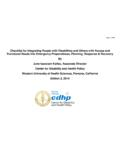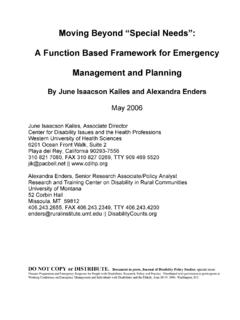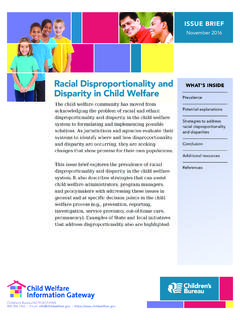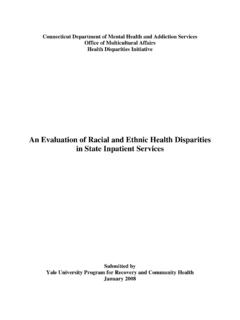Transcription of Moving Beyond ÒSpecial NeedsÓ - June Isaacson …
1 Moving Beyond special needs . A Function-Based Framework for Emergency Management and Planning June Isaacson Kailes Western University of Health Sciences Alexandra Enders University of Montana Disaster preparation and emergency response processes, procedures, and systems can be made more ef- fective for people with disabilities, as well as for the population as a whole. An essential element of build- ing appropriate levels of capacity, specific planning, and response success is to move Beyond use of the special needs category, to better identify and address the diverse needs of those included under this label.
2 This article provides disability demographics and describes special needs populations to lay the foundation for this change. It suggests the development of a more accurate and flexible planning and response framework based on essential, sometimes overlapping, functional needs : communication, medical needs , maintaining functional independence, supervision, and transportation (C-MIST). It also proposes new approaches to functional support, leadership, service delivery, and training. The 2005 hurricane season in the United States reinforced the ognize and meet their needs in an emergency. As it is widely need to discontinue the use of all-inclusive labels such as spe- used within disaster services and the emergency management cial needs for disaster planning.
3 Combining groups too broadly field, the term special needs generally includes an extremely translates into imprecise planning and, as a result, emergency broad group of people, including people with disabilities, peo- response failures. As the term is typically used, the special ple with serious mental illness, minority groups, non English needs population makes up at least half of the population. speakers, children, and the elderly (Centers for Disease Control The label special needs generally incorporates people whose and Prevention [CDC], 2004). Other lists add single working functional needs include assistance with communication, medi- parents, people without vehicles, people with special dietary cal needs , maintaining functional independence, supervision, needs (Federal Emergency Management Agency [FEMA], and transportation (C-MIST).)
4 Not receiving C-MIST support 2004), pregnant women, prisoners, people who are homeless, when it is needed can have severe consequences for those who and others. While there appears to be little consensus on ex- need it. As a result, to ensure that the needs of this large seg- actly who should be included in the special needs category, ment of the population receive necessary attention, it is vital these groups represent a large and complex variety of concerns that disaster preparation include a plan for operationalizing and challenges for disaster planning and response. Many of support for the population's needs .
5 These groups have little in common Beyond the fact that they The purpose of this article is to begin to identify the are often left out of programs, services, and emergency plan- groups included in the population of special needs that require ning (Kailes, 2000; National Council on Disability, 2005). specific disaster planning above and Beyond the average per- We conducted a demographic analysis to estimate the son. In addition, we explore a framework for disaster plan- size of the special needs category. For consistency, we used the ning based upon identifying and addressing functional needs decennial Census 2000 data.
6 The total of the most typical through the use of functional supports, leadership, service de- groups of special needs populations people with disabilities, livery, and training. including people with serious mental illness; people who do not speak English or do not speak English well; children, ages 15 years and under; and people 65 years old and over was al- Who Are People With special needs ? most 141 million people, of the population. Table 1. shows the categories used, with age ranges for each. Everyone Identifying the demographics of who is included in the term in the ages 15-years-and-under and ages 65-years-and-older special needs will help planners better understand how to rec- categories was included.
7 Because people with disabilities were 230 JOURNAL OF DISABILITY POLICY STUDIES VOL . 17/ NO. 4/2007/ PP. 230 237. JOURNAL OF DISABILITY POLICY STUDIES VOL . 17/ NO. 4/2007 231. TABLE 1 2005). The Census 2000 reported more than 70 million mi- Emergency Management special needs Groups: nority individuals if the White alone population is sub- Percentage of the Population tracted from the total population. Because minorities were included in the age categories of 15 years and under and 65. % total years and older, only the population ages 16 to 64 years are Population category Total population counted here.
8 Further adjusting for minority-group individu- Children, age 15 and younger 64,272,779 als who do not speak English and who are counted in the lan- Elderly, age 65 and older 34,991,753 guage category leaves 35 million to 40 million minority group individuals in the 16- to 64-year-old category. Speak English not well, 5,703,904 Other groups with function-based needs that may not be ages 18 64 yrs captured in this analysis include people who are morbidly Speak English not at all, 2,575,154 obese, pregnant women, people on kidney dialysis, and people ages 18 64 yrs living in zero-vehicle households (see Note 2).
9 Noninstitutionalized population 33,153,211 Obesity: People with morbid obesity can pre- with a disability, ages 16 64 yrs sent a range of challenges in emergency manage- Total special needs population 140,696,801 ment, from adequate rescue transportation Note. Data source: Census Bureau, Census 2000, Summary File 1: Table P2, total modes to beds and chairs that will support population; Table PCT12, total population, sex by age. Summary File 3: Table P19, age them. The American Obesity Association ( ). by language spoken at home by ability to speak English for the population 5 years and over; Table P42, sex by age by disability status for the civilian noninstitutionalized pop- reported that approximately 9 million adult ulation age 5 years and over.
10 Americans are morbidly obese, defined as hav- ing a Body Mass Index (BMI) of 40 or more. The prevalence of morbid obesity in 2003 2004 was included in the 15-years-and-under and 65-years-and-older in men and in women (Ogden et al., age categories, only the population 16 to 64 years was included 2006). in the disability category. This was necessary to avoid overcount- Pregnancy. The American Pregnancy Associa- ing when an individual, such as a 70-year-old person with a tion ( ) reported that approximately 6 million disability, was in more than one category. Census data were not pregnancies occur every year in the United available for 16- and 17-year-olds who do not speak English or States.









